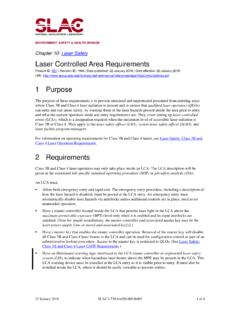Transcription of JP 3-09.1 Joint Laser Designation Procedures (JLASER)
1 Joint LASERDESIGNATION Procedures (JLASER) 1 JUNE 1991 Joint PUB large body of Joint doctrine (and its supporting tactics, techniques,and Procedures ) has been and is being developed by the US Armed Forcesthrough the combined efforts of the Joint Staff, Services, and following chart displays an overview of the developmentprocess for these A Joint PUBPROJECTPROPOSAL.,All Joint doctrine and tactics, techniques,and Procedures are organizedinto a comprehensive Pub 3 04 .1 is located in theoperations series of Joint publications . Joint Pub 1 01," Joint Publication System, "provides a detailed list ofall Joint pubs are also available on CD ROM throughthe Joint Electronic Library(JEL).
2 For information,contact :JointDoctrine Division, J-7,7000 Joint Staff PentagonWashington, D. 7000 .i Joint Laser Designation Procedures Joint PUB PREFACE1. Purpose. This publication provides Joint Procedures for employinglaser designators with target acquisition systems and Laser -guidedweapons to enhance the combat effectiveness of Joint US Application a. Procedures established in this publication apply to the commanders of combatant commands, Joint task forces, and the subordinate components of these commands.
3 These Procedures may also apply when significant forces of one Service are attached to forces of another Service or when significant forces of one Service support forces of another Service, under criteria set forth in this publication. b. In applying the Procedures set forth in this publication, care must be taken to distinguish between distinct but related responsibilities in the two channels of authority to forces assigned to combatant commands. The Military Departments and Services recruit, organize, train, equip, and provide forces for assignment to combatant commands and administer and support these forces.
4 CINCs exercise Combatant Command (command authority) over these forces. Service component commanders are responsible to both Joint force commanders in the operational chain of command and to the Military Departments and Services in the chain of command for matters that the Joint force commander has not been assigned Scope. This publication: a. Encompasses Joint tactics, techniques, and Procedures for employing Laser designators with acquisition devices and Laser guided munitions. b. Describes J- Laser planning and coordination Procedures . c. Describes Laser system capabilities and TABLE OF CONTENTSCHAPTER PAGE I CONCEPT.
5 I-1 Introduction ..I-1 Laser Use on the Battlefield .. I-1 Laser Target Acquisition ..I-2 Enemy Use of Laser Countermeasures..I-3 Summary ..I-3II PLANNING CONSIDERATIONS .. II-1 Laser Designator Characteristics .. II-1 Environmental Restrictions .. II-6 Seeker Characteristics .. II-8 Seeker Types .. II-8 Target Types .. II-9 Designator Operator Positioning Considerations .. II-9 Offset Laser Designation .. II-10 Delayed Laser Designation for LGBs .. II-10 Redundant Laser Designation .. II-11 Current and Projected Laser Systems Description .. II-11 III Procedures ..III-1 General Procedures .
6 III-1 Laser Designation for Artillery ..III-3 Laser Designation for Naval Gunfire Support ..III-5 Laser Designation for CAS ..III-7 Rotary Wing Close-In Fire Support .. III-18IV Laser CODES .. IV-1 Introduction.. IV-1 Controlling and Coordinating Coded Laser Systems.. IV-1 Management of Designator and Weapon Settings.. IV-2 Laser Coding in Conjunction With LGBs .. IV-3 Communications.. IV-3 Coding Prioritization .. IV-3iiiV SAFETY ..V-1 Danger ..V-1 Laser Eye Safety ..V-1 Organizational Safety Considerations ..V-2 APPENDIX A Laser Equipment Descriptions ..A-1 B Procedures Guide.
7 B-1 C J-FIRE Close Air Support Brief ..C-1 D LGB/LLLGB Delivery Profiles..D-1 E References ..E-1 GLOSSARY..GL-1 Part I--Abbreviations.. GL-1 Part II--Definitions .. GL-3 FIGURE II-1 Beam Divergence ..II-1 II-2 Mirrorlike Reflections (Perpendicular) ..II-2 II-3 Mirrorlike Reflections (Angular) ..II-2 II-4 Scattered Reflections ..II-2 II-5 Laser Spillover ..II-2 II-6 Podium Effect ..II-3 II-7 Target Reflections (Perpendicular) ..II-4 II-8 Target Reflections (Angular)..II-4 II-9 Vertical Reflections (Detectable) ..II-4 II-10 Vertical Reflections (Blocked).
8 II-5 II-11 Reflection in a Chosen Direction ..II-5 A-1 Laser Systems Quick Reference Summary ..A-3 A-2 Laser Systems Planning Considerations Quick Reference Summary: Equipment/Systems.. A-5 A-3 Laser Systems Planning Considerations Quick Reference Summary: Aircraft/Equipment..A-6 A-4 Laser Systems Planning Considerations Quick Reference Summary: Environment.. A-7 B-1 COPPERHEAD Footprint Template Card ..B-4 B-2 Ground and Airborne Laser Designation Procedures for COPPERHEAD CLGPs .. B-8 B-3 Ground and Airborne Laser Designation Procedures for NGFS Call for Fire Mission.
9 B-10 B-4 Procedures for Aircraft with LST/LGW.. B-15 B-5 HELLFIRE Missile Surface Danger Zone for Direct Launch.. B-21iv B-6 HELLFIRE Missile Surface Danger Zone for Indirect Launch (Lock-On After Launch) at Fixed Target B-22 B-7 Designator Zones for Use With HELLFIRE Surface Danger Zones.. B-23 B-8 Procedures for Helicopters With LST/LGM .. B-24 D-1 LGB/LLLGB Dive Delivery Tactic Permissive Threat) .. D-1 D-2 LGB/LLLGB Low-Level Loft Delivery Tactic (Sophisticated Threat-Target Identification-- No Problem).
10 D-3 D-3 LGB/LLLGB Popup Delivery Tactic (Sophisticated Threat-Target Identification--Difficult).. D-4I-1 CHAPTER I CONCEPT1. Introduction a. Fighting the Modern Battle. Modern battles will be fought and won by multi-Service forces employed in Joint operations. As the complexity of the battlefield increases, developing technologies must meet the challenge. One of the newest technologies is the Laser system. b. Laser Capabilities. Laser designators radiate a narrow beam of pulsed energy. Current tactical lasers operate in the near-infrared wavelength spectrum, which is not visible to the human eye.



















